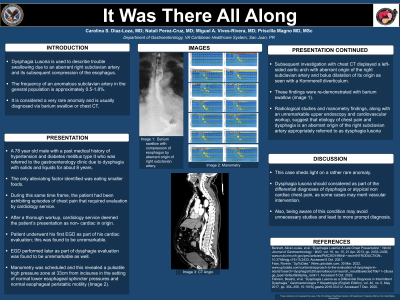Back


Poster Session E - Tuesday Afternoon
Category: Esophagus
E0225 - It Was There All Along
Tuesday, October 25, 2022
3:00 PM – 5:00 PM ET
Location: Crown Ballroom

Has Audio

Carolina S. Diaz-Loza, MD
VA Caribbean Health Care System
San Juan, Puerto Rico
Presenting Author(s)
Carolina S. Diaz-Loza, MD, Natali M. Perez-Cruz, MD, Miguel A. Vives-Rivera, MD, Priscilla Magno, MD, MSc
VA Caribbean Health Care System, San Juan, Puerto Rico
Introduction: Dysphagia Lusoria is used to describe trouble swallowing due to an aberrant right subclavian artery and its subsequent compression of the esophagus. The frequency of an anomalous subclavian artery in the general population is approximately 0.5-1.8%. It is considered a very rare anomaly and is usually diagnosed via barium swallow or chest CT.
Case Description/Methods: This is the case of a 78 year old male with a past medical history of hypertension and diabetes mellitus type II who was referred to the gastroenterology clinic due to dysphagia with solids and liquids for about 8 years. The only alleviating factor identified was eating smaller foods. During this same time frame, the patient had been exhibiting episodes of chest pain that required evaluation by cardiology service. However, after a thorough workup, cardiology service deemed the patient’s presentation as non- cardiac in origin. Patient underwent his first EGD as part of his cardiac evaluation; this was found to be unremarkable. EGD performed later as part of dysphagia evaluation was found to be unremarkable as well. As a result, manometry was scheduled and this revealed a pulsatile high pressure zone at 33cm from incisures in the setting of normal lower esophageal sphincter pressures and normal esophageal peristaltic motility. Subsequent investigation with chest CT displayed a left-sided aortic arch with aberrant origin of the right subclavian artery and bolus dilatation of its origin as seen with a Kommerell diverticulum. These findings were re-demonstrated with barium swallow. Radiological studies and manometry findings, along with an unremarkable upper endoscopy and cardiovascular workup, suggest that etiology of chest pain and dysphagia is an aberrant origin of the right subclavian artery appropriately referred to as dysphagia lusoria.
Discussion: This case sheds light on a rather rare anomaly which should be considered as part of the differential diagnoses of dysphagia or atypical non cardiac chest pain, as some cases may merit vascular intervention. Also, being aware of this condition may avoid unnecessary studies and lead to more prompt diagnosis.
Disclosures:
Carolina S. Diaz-Loza, MD, Natali M. Perez-Cruz, MD, Miguel A. Vives-Rivera, MD, Priscilla Magno, MD, MSc. E0225 - It Was There All Along, ACG 2022 Annual Scientific Meeting Abstracts. Charlotte, NC: American College of Gastroenterology.
VA Caribbean Health Care System, San Juan, Puerto Rico
Introduction: Dysphagia Lusoria is used to describe trouble swallowing due to an aberrant right subclavian artery and its subsequent compression of the esophagus. The frequency of an anomalous subclavian artery in the general population is approximately 0.5-1.8%. It is considered a very rare anomaly and is usually diagnosed via barium swallow or chest CT.
Case Description/Methods: This is the case of a 78 year old male with a past medical history of hypertension and diabetes mellitus type II who was referred to the gastroenterology clinic due to dysphagia with solids and liquids for about 8 years. The only alleviating factor identified was eating smaller foods. During this same time frame, the patient had been exhibiting episodes of chest pain that required evaluation by cardiology service. However, after a thorough workup, cardiology service deemed the patient’s presentation as non- cardiac in origin. Patient underwent his first EGD as part of his cardiac evaluation; this was found to be unremarkable. EGD performed later as part of dysphagia evaluation was found to be unremarkable as well. As a result, manometry was scheduled and this revealed a pulsatile high pressure zone at 33cm from incisures in the setting of normal lower esophageal sphincter pressures and normal esophageal peristaltic motility. Subsequent investigation with chest CT displayed a left-sided aortic arch with aberrant origin of the right subclavian artery and bolus dilatation of its origin as seen with a Kommerell diverticulum. These findings were re-demonstrated with barium swallow. Radiological studies and manometry findings, along with an unremarkable upper endoscopy and cardiovascular workup, suggest that etiology of chest pain and dysphagia is an aberrant origin of the right subclavian artery appropriately referred to as dysphagia lusoria.
Discussion: This case sheds light on a rather rare anomaly which should be considered as part of the differential diagnoses of dysphagia or atypical non cardiac chest pain, as some cases may merit vascular intervention. Also, being aware of this condition may avoid unnecessary studies and lead to more prompt diagnosis.
Disclosures:
Carolina Diaz-Loza indicated no relevant financial relationships.
Natali Perez-Cruz indicated no relevant financial relationships.
Miguel Vives-Rivera indicated no relevant financial relationships.
Priscilla Magno indicated no relevant financial relationships.
Carolina S. Diaz-Loza, MD, Natali M. Perez-Cruz, MD, Miguel A. Vives-Rivera, MD, Priscilla Magno, MD, MSc. E0225 - It Was There All Along, ACG 2022 Annual Scientific Meeting Abstracts. Charlotte, NC: American College of Gastroenterology.
